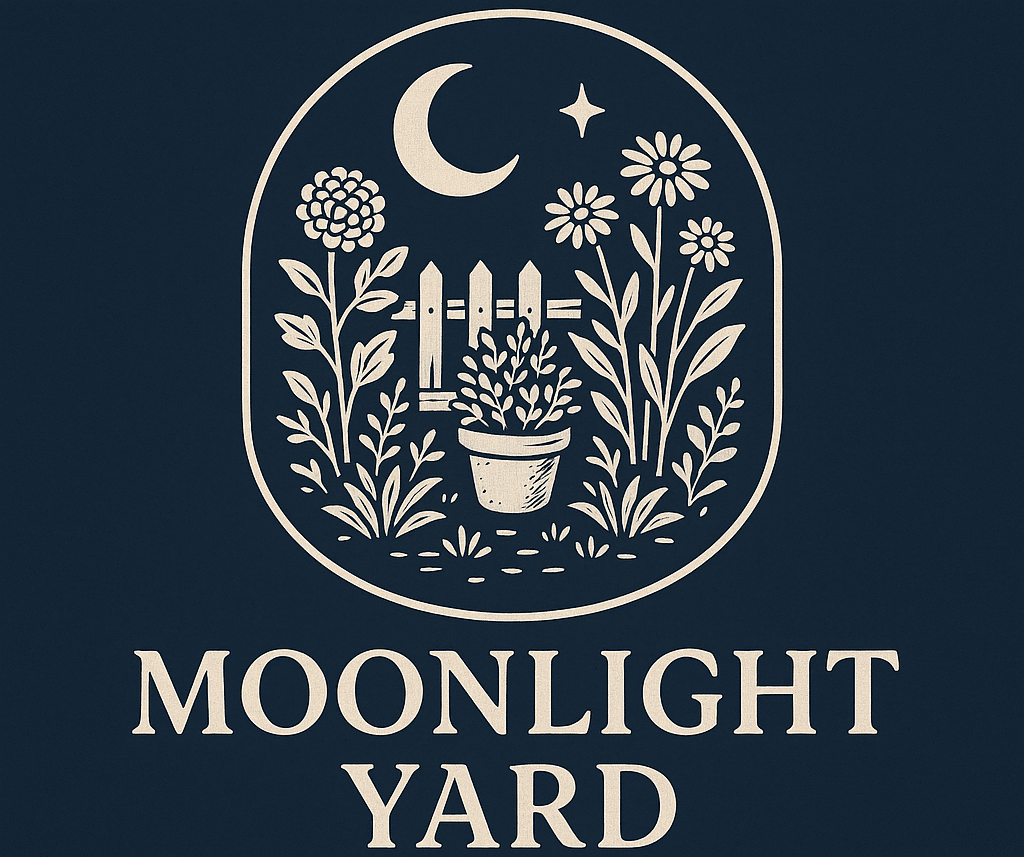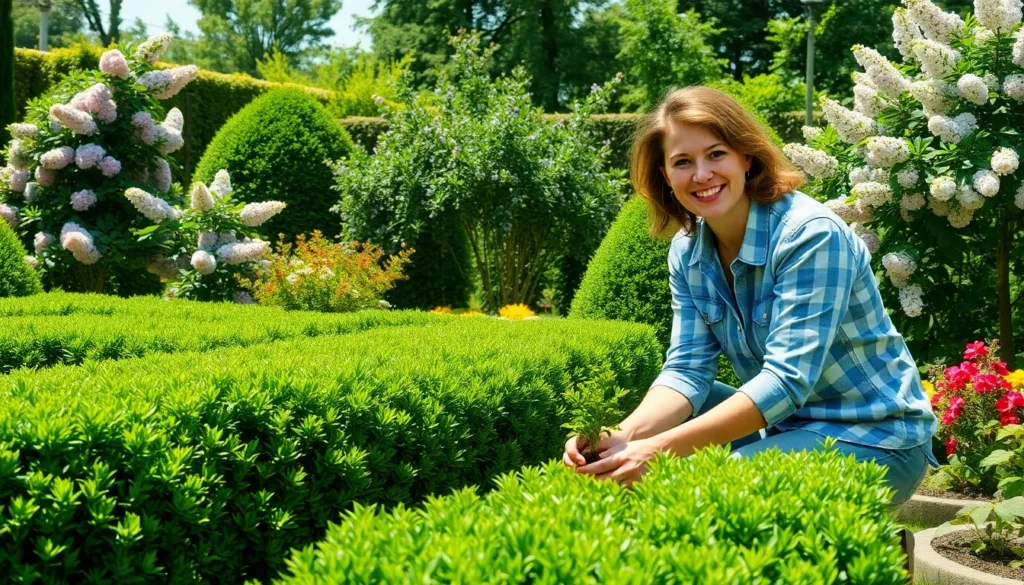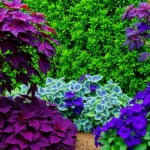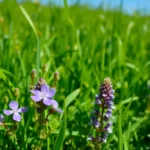We’ve all stood at our garden’s edge wondering how to create that perfect natural boundary that’s both beautiful and functional. Garden hedges offer an incredible solution that goes far beyond simple property lines – they’re living sculptures that can transform your outdoor space into a private sanctuary.
Whether you’re looking to block unsightly views, create intimate garden rooms, or simply add year-round structure to your industry, the right hedge can become your garden’s most valuable asset. From fast-growing privacy screens to perfectly manicured formal borders, there’s a hedge solution for every style and budget.
The best part? Creating stunning garden hedges doesn’t require a green thumb or massive investment. With the right plant choices and basic maintenance knowledge, you’ll soon have neighbors asking for your landscaping secrets. Let’s explore the most effective hedge ideas that’ll elevate your garden from ordinary to extraordinary.
Classic Evergreen Hedge Ideas for Year-Round Privacy
Evergreen hedges deliver consistent privacy and structure throughout every season. These timeless options maintain their lush appearance during winter months when deciduous plants lose their foliage.
Boxwood Hedges for Formal Garden Design
Boxwood hedges create crisp geometric lines that define elegant outdoor spaces with architectural precision. We recommend English boxwood (Buxus sempervirens) for its dense growth habit and excellent shaping capabilities.
Plant boxwood shrubs 12 to 18 inches apart to establish a solid hedge foundation within 2 to 3 years. These slow growing plants typically add 3 to 6 inches of height annually.
Maintain boxwood hedges through regular trimming during late spring and early fall seasons. The dense foliage responds beautifully to pruning shears and creates perfectly manicured edges for formal landscapes.
Choose boxwood varieties based on your climate zone since some cultivars tolerate cold temperatures better than others. American boxwood thrives in zones 5 through 8 while Korean boxwood handles zone 4 conditions.
Yew Hedges for Traditional English Garden Style
Yew hedges offer exceptional longevity with specimens living for hundreds of years in established gardens. English yew (Taxus baccata) creates the classic backdrop for traditional garden rooms and formal parterre designs.
Space yew plants 24 to 36 inches apart to allow proper air circulation while ensuring dense coverage develops over time. These adaptable evergreens grow 6 to 12 inches per year in optimal conditions.
Trim yew hedges twice annually during late spring and late summer to maintain their refined appearance. The dark green foliage provides an excellent contrast against colorful flowering plants and creates dramatic garden focal points.
Consider yew hedges for shaded locations where other evergreens struggle to thrive. These versatile plants tolerate partial shade conditions and various soil types including clay and sandy compositions.
Arborvitae Hedges for Fast-Growing Privacy Screens
Arborvitae hedges establish privacy quickly with growth rates reaching 12 to 24 inches per year depending on the variety selected. Emerald Green arborvitae (Thuja occidentalis ‘Emerald Green’) maintains its compact pyramidal shape without frequent pruning.
Install arborvitae plants 3 to 4 feet apart for privacy screens that fill in completely within 3 to 5 years. These hardy evergreens adapt to different soil conditions and tolerate urban pollution.
Water arborvitae hedges consistently during establishment to promote healthy root development and vigorous growth patterns. Deep weekly watering sessions encourage strong anchor roots that support tall hedge structures.
Select disease resistant arborvitae cultivars such as Green Giant or Techny varieties that withstand common fungal issues. These improved selections maintain their vibrant color throughout winter months without browning or needle drop.
Flowering Hedge Ideas to Add Color and Fragrance
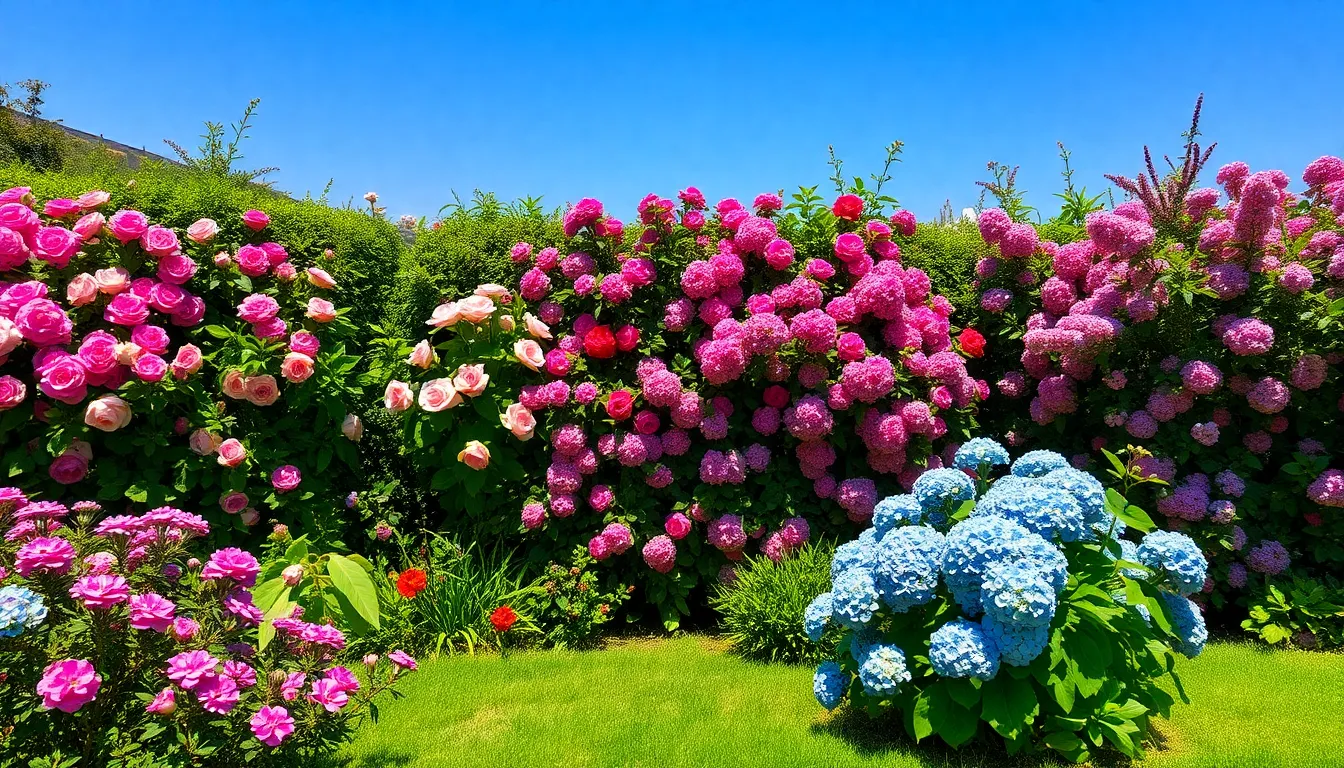
When we want to combine privacy with beauty, flowering hedges transform ordinary garden boundaries into stunning displays of color and fragrance throughout the seasons.
Rose Hedges for Romantic Garden Borders
Rose hedges create romantic garden borders with their lush blooms and fragrant scents that captivate visitors throughout the growing season. We recommend selecting repeat-blooming varieties like Knockout roses or rugosa roses that provide continuous color from spring through fall. These flowering shrubs require regular care including weekly watering and monthly fertilizing during the growing season, but they reward us with stunning displays of color in shades ranging from classic red to soft pink and pristine white.
Plant rose hedges 3 to 4 feet apart to allow proper air circulation and prevent disease issues. Regular pruning in late winter helps maintain shape and encourages vigorous blooming throughout the season. The dense foliage provides excellent privacy while the thorny stems add natural security to property boundaries.
Lilac Hedges for Spring Blooms and Sweet Scents
Lilac hedges are renowned for their beautiful purple blooms and sweet fragrance that announces spring’s arrival in the most delightful way. We particularly love common lilac varieties that produce dense clusters of fragrant flowers in shades of purple, white, and pink during late spring. These hardy shrubs adapt well to various soil conditions and require minimal maintenance once established.
Space lilac plants 4 to 6 feet apart to accommodate their mature spread and ensure proper air circulation. Prune immediately after flowering to maintain shape and encourage next year’s bloom development. The dense foliage provides excellent screening while the seasonal flower display creates a fragrant focal point that attracts beneficial pollinators like butterflies and bees.
Hydrangea Hedges for Summer-Long Color Display
Hydrangea hedges offer a long-lasting display of color in summer with their large, showy flowers that maintain their beauty for months rather than weeks. We recommend varieties like Endless Summer or Limelight hydrangeas that produce massive flower clusters measuring 6 to 12 inches across. These flowering shrubs thrive in partial shade conditions and provide consistent blooms from mid-summer through early fall.
Plant hydrangeas 4 to 5 feet apart to allow for their substantial mature size and spreading growth habit. Regular watering during dry spells keeps the large leaves healthy and supports continuous flower production. The broad foliage creates effective privacy screening while the dramatic flower displays add architectural interest to garden borders throughout the warmest months of the year.
Low-Maintenance Hedge Ideas for Busy Gardeners

Creating beautiful garden boundaries doesn’t have to consume your weekends. We’ve selected hedge varieties that require minimal attention while delivering maximum impact for time-pressed homeowners.
Privet Hedges for Minimal Care Requirements
Privet hedges deliver exceptional value with their fast-growing nature and minimal maintenance demands. These adaptable plants thrive in various soil conditions and tolerate both sun and partial shade environments.
Growing rapidly to establish privacy quickly, privet hedges require only seasonal trimming to maintain their shape. We recommend trimming twice per year – once in late spring and again in midsummer – to keep them looking neat and controlled.
Their dense foliage creates excellent screening while remaining remarkably forgiving of occasional neglect. Privet varieties like Ligustrum ovalifolium produce small white flowers in summer, adding subtle seasonal interest without requiring additional care.
Drought tolerance makes privet hedges particularly suitable for busy gardeners who can’t maintain regular watering schedules. Once established, these hardy plants survive on natural rainfall in most climates.
Forsythia Hedges for Easy Seasonal Interest
Forsythia hedges provide spectacular spring displays with minimal effort throughout the growing season. These cheerful shrubs burst into vibrant yellow blooms before their leaves emerge, creating stunning early-season color.
Maintaining forsythia hedges requires only annual pruning immediately after flowering to preserve next year’s blooms. We suggest cutting back one-third of the oldest stems to ground level each year to encourage healthy growth.
Their rapid growth rate establishes privacy screens within 2-3 seasons while requiring no fertilization in average soils. Forsythia varieties like Forsythia x intermedia reach 6-8 feet tall and wide, creating substantial boundaries with ease.
Pest resistance keeps maintenance requirements minimal, as forsythia rarely suffers from serious insect or disease problems. This reliability makes them perfect choices for gardeners seeking beautiful hedges without constant monitoring.
Spirea Hedges for Drought-Tolerant Landscaping
Spirea hedges excel in challenging conditions where other plants struggle to survive. These resilient shrubs adapt to various soil types and thrive with minimal water once established.
Offering diverse seasonal colors, spirea varieties provide spring flowers ranging from white to pink, followed by attractive foliage that often changes color in fall. Spiraea vanhouttei creates graceful arching branches covered in white flower clusters, while Spiraea japonica varieties offer colorful foliage options.
Pruning requirements remain simple, with most spirea hedges needing only light shaping after their spring bloom period. We recommend removing spent flowers to encourage potential second blooms and maintain tidy appearances.
Their compact growth habits suit smaller gardens where space constraints limit hedge options. Most spirea varieties reach 3-6 feet in height, making them manageable for homeowners who prefer lower-maintenance industry features.
Natural pest resistance reduces the need for chemical treatments, while their tolerance for neglect makes them ideal for vacation properties or weekend gardens.
Edible Hedge Ideas for Functional Garden Boundaries

We can transform our garden boundaries into productive spaces that provide food while maintaining their traditional screening function. Functional hedges offer the perfect solution for gardeners who want beauty and bounty in equal measure.
Blueberry Hedges for Fruit Production and Fall Color
Blueberry hedges deliver exceptional value by producing delicious fruit while creating stunning seasonal displays. These versatile plants thrive in acidic soil conditions and require consistent moisture throughout the growing season. We recommend spacing blueberry plants 4 to 6 feet apart to allow proper air circulation and growth.
Northern highbush varieties like Duke, Blueray, and Jersey perform exceptionally well in cooler climates and produce abundant harvests. Fall foliage transforms these hedges into brilliant displays of orange, red, and yellow colors that rival any ornamental shrub. Pruning should occur in late winter before new growth begins, focusing on removing dead wood and maintaining shape.
Soil preparation proves critical for blueberry hedge success, requiring pH levels between 4.5 and 5.5 for optimal nutrient uptake. Adding peat moss, sulfur, or pine needles helps create the acidic conditions these plants crave while improving drainage.
Rosemary Hedges for Culinary and Aromatic Benefits
Rosemary hedges provide year round evergreen foliage while offering fresh herbs for our kitchen needs. This Mediterranean native adapts well to hedge applications and releases its distinctive fragrance whenever we brush against the foliage. Upright varieties such as Tuscan Blue and Miss Jessop’s Upright work best for formal hedge designs.
Planting spacing of 18 to 24 inches creates dense coverage while allowing adequate air circulation between plants. Regular pruning maintains shape and encourages bushier growth, with the best timing occurring after flowering in late spring or early summer. We can harvest rosemary sprigs throughout the year for cooking, making these hedges both practical and aromatic.
Cold hardiness varies among rosemary varieties, with some tolerating temperatures down to zone 6 while others require protection in colder regions. Choosing cold hardy cultivars like Arp or Hill Hardy ensures our rosemary hedges survive harsh winters and continue providing culinary benefits year after year.
Bamboo Hedges for Sustainable Garden Answers
Bamboo hedges offer rapid growth and excellent screening capabilities while supporting environmental sustainability goals. Clumping bamboo varieties like Bambusa multiplex and Fargesia species provide natural privacy screens without the aggressive spreading behavior of running bamboos. These plants can reach mature heights of 8 to 15 feet within just a few growing seasons.
Growth rates of 2 to 4 feet per year make bamboo an ideal choice for gardeners seeking quick results from their hedge investments. Regular maintenance involves removing dead canes and controlling height through selective pruning during the growing season. We should install root barriers for running bamboo types to prevent unwanted spreading into neighboring areas.
Environmental benefits include carbon sequestration, oxygen production, and habitat creation for beneficial wildlife species. Bamboo produces more oxygen per square foot than most tree species while requiring minimal water and fertilizer inputs once established. Wind resistance makes these hedges excellent choices for exposed locations where other plants might struggle.
Decorative Hedge Ideas for Unique Garden Features
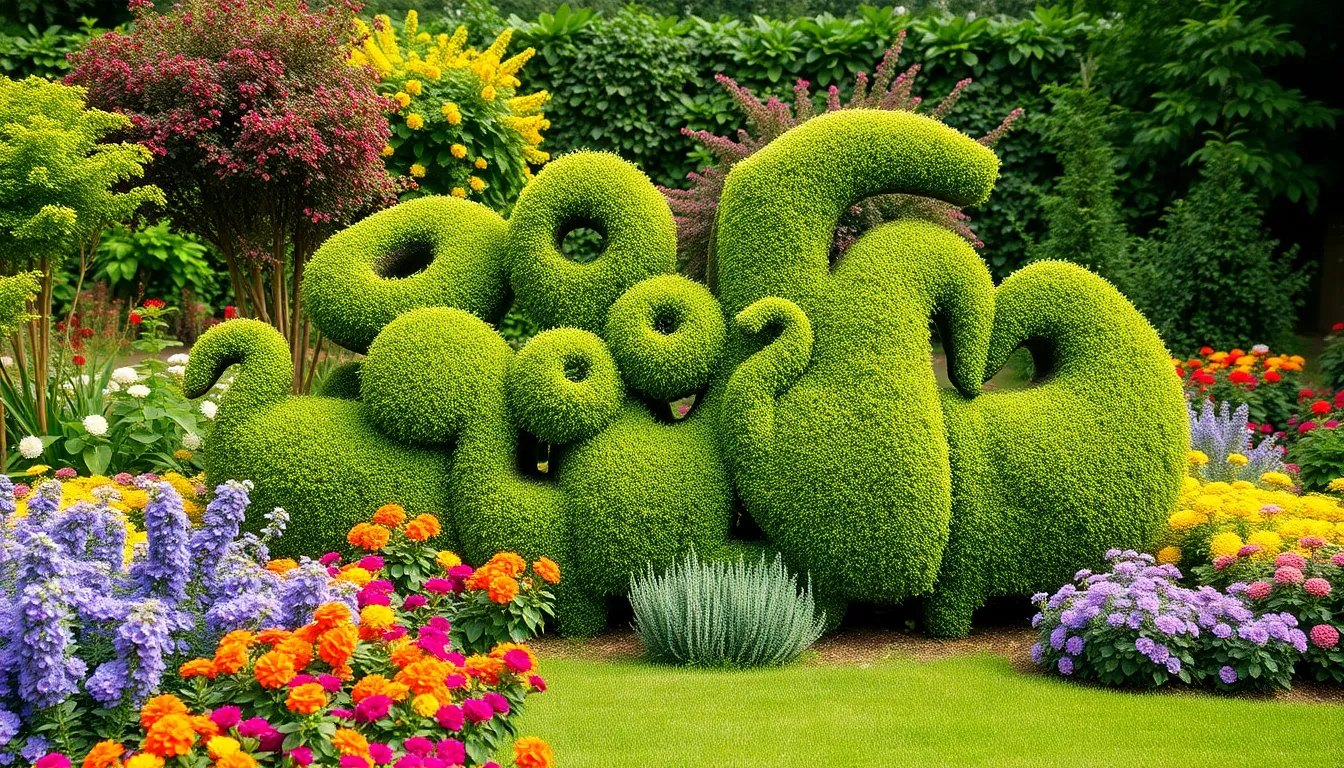
Transform your garden boundaries into stunning focal points with decorative hedging techniques that go beyond traditional straight lines. Creative hedge designs can add personality and artistic flair to any outdoor space.
Topiary Hedges for Artistic Garden Elements
Sculpted hedges bring an artistic dimension to garden design through the ancient art of topiary trimming. We can create whimsical animal shapes like rabbits, birds, or elephants that add playful charm to family gardens. Geometric forms such as spheres, cones, and pyramids offer a more formal aesthetic perfect for contemporary landscapes.
Free-standing topiary designs work beautifully as garden centerpieces or accent features throughout your outdoor space. These sculptural elements require regular maintenance every 6-8 weeks during growing season to maintain their crisp lines. Popular plants for topiary work include boxwood, yew, and privet due to their dense growth habits and tolerance for frequent trimming.
Professional topiary artists recommend starting with simple shapes before attempting complex designs. Spiral forms and tiered wedding cake styles provide intermediate challenges for developing gardeners ready to advance their skills.
Mixed Species Hedges for Diverse Texture and Color
Combining different plant species creates hedges with ever-changing visual interest throughout all four seasons. Evergreen and deciduous plant combinations offer the best of both worlds, providing year-round structure while delivering seasonal color changes. Holly paired with dogwood creates stunning winter interest with bright berries against colorful stems.
Flowering shrubs integrated into hedge designs introduce vibrant colors and delightful fragrances during bloom periods. Weigela mixed with spirea delivers pink and white flowers at different times, extending the flowering season from spring through summer. Rose bushes combined with lavender create romantic cottage garden hedges with complementary colors and scents.
Texture variation adds depth to mixed species hedges through contrasting leaf shapes and growth patterns. Fine-textured plants like boxwood paired with bold-leaved rhododendrons create striking visual contrast. Planning bloom times ensures continuous color from early spring bulbs through late-season asters.
Dwarf Hedge Ideas for Small Garden Spaces
Compact hedge varieties deliver maximum impact in minimal space, making them perfect for urban gardens and small yards. Boxwood and yew selections remain the most popular choices for dwarf hedging due to their naturally compact growth and exceptional shaping tolerance. These varieties typically reach 2-3 feet in height with regular trimming.
Compact shrubs like dwarf lavender create soft, natural-looking borders while providing aromatic benefits and pollinator-friendly flowers. Heather varieties offer low-maintenance options with beautiful bell-shaped flowers in purple, pink, or white. These plants thrive in poor soil conditions where other hedging materials might struggle.
Dwarf hedge spacing typically requires plants placed 12-18 inches apart for proper coverage within two growing seasons. Miniature barberry cultivars provide thorny security features in small spaces while delivering brilliant fall colors. Japanese holly dwarf varieties maintain dense growth habits perfect for formal edge definition in compact garden designs.
Small space hedging works exceptionally well for defining separate garden rooms or creating intimate seating areas. Container hedging options allow renters and apartment dwellers to enjoy hedge benefits without permanent installation commitments.
Seasonal Hedge Ideas for Dynamic Garden Interest
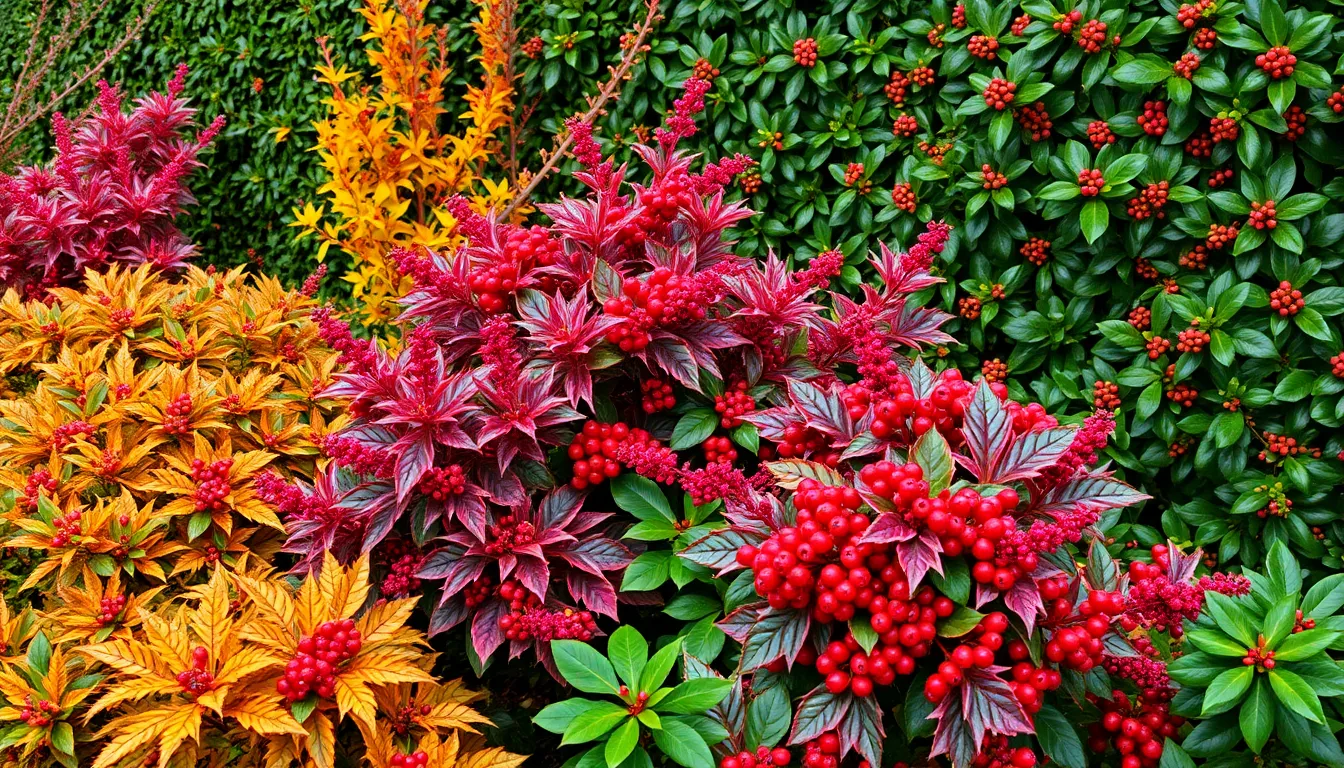
Creating a garden that captivates throughout the year requires strategic plant selection that delivers visual interest across all seasons. We’ll explore hedge options that transform your garden boundaries from static screens into ever-changing displays of color, texture, and wildlife activity.
Deciduous Hedges for Changing Autumn Colors
Deciduous hedges offer spectacular seasonal transformations that evergreens simply can’t match. Beech hedges create stunning displays with their orange to brown fall colors while retaining many leaves through winter for continued structure and shelter. Hornbeam provides similar autumn appeal with its reliable color changes and winter interest.
Maple varieties deliver vibrant reds and oranges that rival any ornamental tree display. Serviceberry hedges reward us with brilliant yellow and red foliage plus edible berries for a dual purpose design. Viburnum species contribute diverse autumn hues ranging from deep burgundy to bright yellow while offering spring flowers as an added bonus.
These changing hedges require minimal maintenance beyond annual pruning and provide year round visual interest even when dormant. We recommend spacing deciduous hedge plants 18 to 24 inches apart for optimal coverage and seasonal impact.
Berry-Producing Hedges for Wildlife Attraction
Berry producing hedges transform garden boundaries into wildlife magnets while adding ornamental value through their colorful fruit displays. Elder shrubs produce clusters of dark berries that attract many bird species while offering edible flowers and fruit for human use. Blackthorn creates dense protective barriers with its thorny branches and produces small dark berries that support local wildlife populations.
Cherry plum hedges provide early spring blossoms followed by colorful fruit that birds eagerly consume throughout late summer. These wildlife friendly options require mixing several berry producing species to create hedges that support biodiversity from late summer into winter.
| Berry Hedge Type | Wildlife Benefits | Fruit Season |
|---|---|---|
| Elder | Birds, beneficial insects | Late summer |
| Blackthorn | Birds, small mammals | Early autumn |
| Cherry Plum | Birds, pollinators | Mid to late summer |
Planning berry hedge layouts with staggered fruiting times ensures consistent wildlife support and extended visual interest throughout the growing season.
Winter Interest Hedges for Cold Season Appeal
Winter interest hedges provide essential structure and color when most garden plants retreat into dormancy. Holly hedges offer glossy evergreen foliage plus bright red berries that create stunning winter displays while providing bird food during harsh months. Boxwood maintains its compact form and rich green color throughout winter making it perfect for formal garden designs that need year round definition.
Yew hedges deliver deep green backdrops that highlight winter garden features like ornamental grasses and colorful bark. Conifer options including juniper and arborvitae provide varied textures and colors from blue green to golden hues that brighten dreary winter landscapes.
Adding grasses or plants with distinctive bark patterns like dogwood species enhances winter hedge appeal through textural contrast. We suggest incorporating at least 30% evergreen elements in mixed hedge designs to maintain winter structure and visual weight during dormant seasons.
These cold season performers require minimal winter care beyond occasional snow removal from branches and spring cleanup of any winter damage.
Budget-Friendly Hedge Ideas for Cost-Effective Landscaping
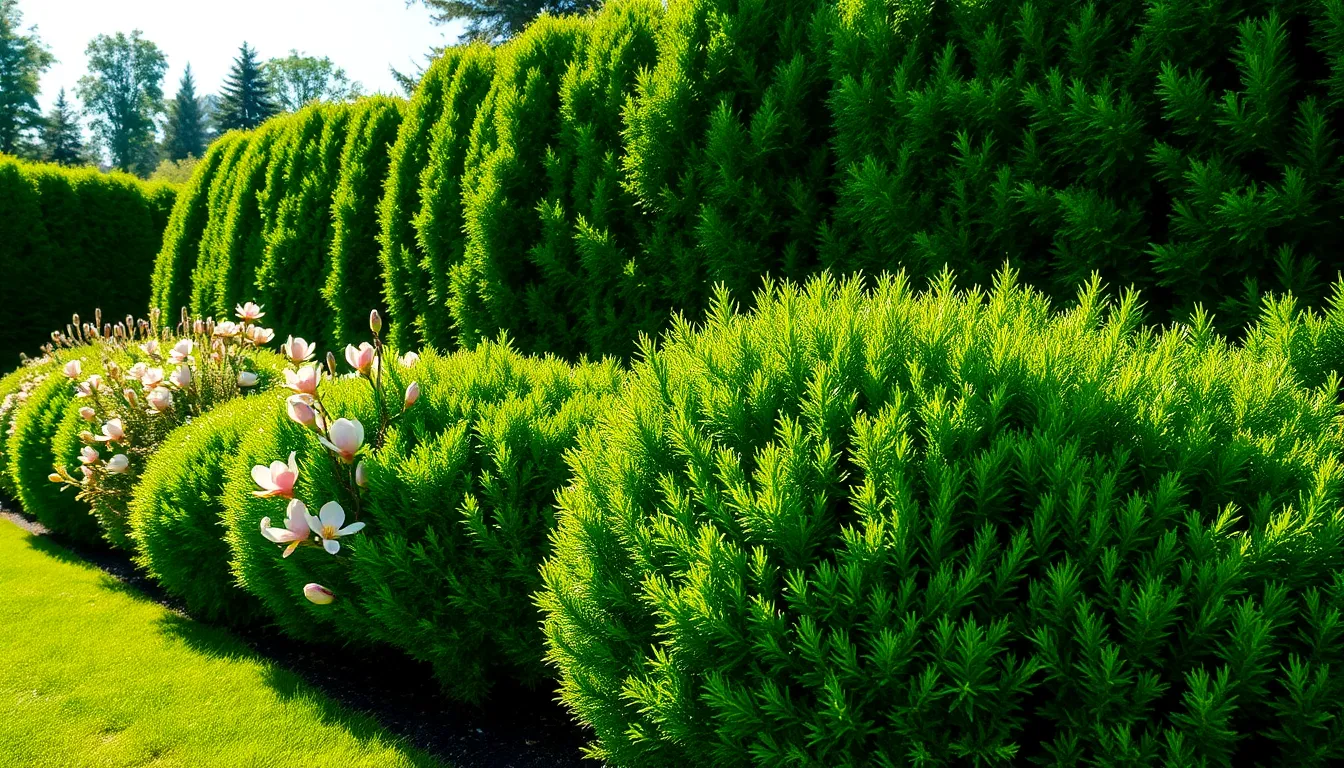
Creating stunning garden boundaries doesn’t require draining your savings account. Smart hedge choices and cost-effective growing methods can transform your outdoor space without breaking the budget.
Fast-Growing Hedge Options for Quick Results
Fairy Magnolias establish dense, attractive hedges within just a few years of planting. These rapidly growing shrubs thrive in well-draining soil and perform best in full sun to partial shade conditions. We recommend spacing them 3-4 feet apart for optimal coverage and pruning them annually to maintain their shape.
Arborvitae hedges deliver impressive privacy screens faster than most traditional options. Their reputation for rapid growth makes them incredibly popular among homeowners seeking quick results. Emerald Green and Green Giant varieties can reach 6-8 feet within 3-4 years when properly maintained. Plant them in spring for best establishment, ensuring they receive adequate water during their first growing season.
Dwarf Golden False Cypress varieties offer both speed and affordability for budget-conscious gardeners. These relatively inexpensive shrubs require minimal care once established and provide year-round color with their golden foliage. Space them 2-3 feet apart for a tight hedge that fills in quickly without requiring extensive maintenance.
Native Plant Hedges for Regional Adaptation
Holly hedges using native varieties like Oakland and Nellie provide excellent adaptation to local growing conditions. These regional natives create dense, low-maintenance barriers that naturally resist local pests and diseases. Native hollies typically require less water and fertilizer than non-native alternatives, reducing long-term maintenance costs significantly.
Local shrub species ensure better survival rates and lower maintenance requirements compared to exotic alternatives. Research native options in your area through local extension offices or native plant societies to identify the most suitable species. These plants have evolved to thrive in your exact climate conditions, requiring fewer inputs and producing more reliable results.
Regional flowering shrubs like native azaleas, elderberry, or serviceberry combine beauty with practicality. These species support local wildlife while providing seasonal interest through flowers, berries, or fall color. Native shrubs typically establish faster and live longer than imported varieties, making them excellent long-term investments.
Propagation Tips for Growing Your Own Hedges
Taking cuttings from existing plants represents the most cost-effective method for expanding your hedge collection. Many shrub species root easily from 4-6 inch semi-hardwood cuttings taken in late summer or early fall. Dip cuttings in rooting hormone and plant them in well-draining potting mix for best results.
Simple layering works exceptionally well for shrubs with flexible branches that can bend to ground level. Bury a portion of a low-growing branch while it’s still attached to the parent plant, allowing it to develop roots before cutting it free. This method ensures higher success rates since the cutting receives nutrients from the parent plant during root development.
Air layering provides more control over the propagation process for shrubs with branches that won’t bend to ground level. Wrap moist sphagnum moss around a wounded section of branch, cover with plastic, and secure both ends. Roots typically develop within 6-8 weeks, creating a new plant that you can separate and transplant.
Bulk purchasing online or through wholesale nurseries significantly reduces per-plant costs compared to retail garden centers. Even boxwood, which can be pricey at local nurseries, becomes much more affordable when purchased in quantities of 25 or more plants. Coordinate with neighbors to split larger orders and maximize savings on shipping costs.
Conclusion
Creating the perfect garden hedge doesn’t have to be overwhelming or expensive. We’ve shown you that whether you’re looking for evergreen privacy screens or colorful flowering boundaries there’s a hedge solution that fits your space and lifestyle.
The key is matching your hedge choice to your exact needs and maintenance preferences. Fast-growing varieties like arborvitae deliver quick results while low-maintenance options like privet keep your weekends free.
Remember that even budget-conscious gardeners can achieve stunning results through propagation techniques and native plant selections. Your dream hedge is within reach regardless of your experience level or garden size.
Start small experiment with different varieties and watch as your garden transforms into the private beautiful space you’ve always envisioned.
Frequently Asked Questions
What are the main benefits of garden hedges?
Garden hedges serve multiple purposes including creating natural boundaries, blocking unsightly views, providing privacy, and adding year-round structure to your outdoor space. They offer both aesthetic appeal and functional benefits while being achievable for gardeners of all skill levels and budgets.
Which evergreen hedges are best for year-round privacy?
Boxwood, yew, and arborvitae are excellent evergreen choices. Boxwood offers crisp geometric lines perfect for formal designs, yew provides traditional English garden style with great adaptability, and arborvitae grows quickly making it ideal for fast privacy screens.
What flowering hedges add color and fragrance to gardens?
Rose hedges with repeat-blooming varieties like Knockout roses provide lush blooms and sweet scents. Lilac hedges offer beautiful purple spring blooms with delightful fragrance, while hydrangea hedges deliver long-lasting summer color in various shades.
Which hedges require the least maintenance?
Privet hedges are fast-growing and drought-tolerant, needing only seasonal trimming. Forsythia hedges require just annual pruning after spring blooms, and spirea hedges are resilient in challenging conditions with simple pruning needs and diverse seasonal colors.
Can I grow edible hedges that are both beautiful and functional?
Yes! Blueberry hedges provide delicious fruit and stunning fall colors. Rosemary hedges offer culinary and aromatic benefits while requiring minimal care. Bamboo hedges grow rapidly, provide excellent screening, and support sustainable gardening practices.
What hedge options work best for small spaces?
Dwarf hedge varieties are perfect for small gardens, providing impactful borders without overwhelming the area. Topiary hedges can be shaped into compact geometric designs, and mixed species hedges offer year-round interest while maintaining manageable sizes.
How can I create stunning hedges on a budget?
Choose fast-growing options like Fairy Magnolias or Arborvitae for quick results. Consider native plant hedges for low maintenance and adaptability. Use propagation techniques like taking cuttings, layering, or bulk purchasing to reduce costs while achieving beautiful boundaries.
Which hedges provide the best seasonal interest?
Deciduous hedges like beech and hornbeam offer stunning autumn colors. Berry-producing hedges attract wildlife while providing ornamental value. Winter interest hedges like holly and boxwood maintain color and structure during cold months for year-round appeal.
